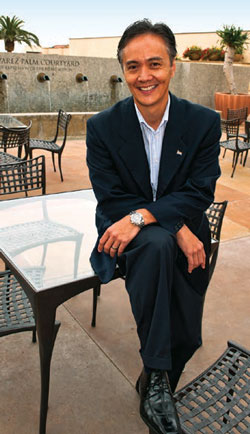Partnering for Progress
Pepperdine Magazine is the feature magazine for Pepperdine University and its growing community of alumni, students, faculty, staff, and friends.
Technology plays an important role at Pepperdine University and in education worldwide. It transforms how we conduct business and serves as a great enabler in teaching and learning. It will do so more noticeably in years in come, and continue to automate and streamline our business processes. At the end of the day, however, technology is simply a tool and nothing more.
 Across the globe in higher education, there is a noticeable pace—a slow one—in the
adoption of technology in teaching and learning. We are experiencing this pace at
Pepperdine as well. As many know, the Information Technology (IT) Division at Pepperdine
conducts an annual technology assessment known as TechQual+. Each year since 2009,
IT surveys a random group of students, faculty, and staff members on their satisfaction
with technology services offered by the University. One question in the survey asks
students to rate faculty use of technology in instruction. Responses indicate that
they want more. This should not come as a surprise. Students of higher education,
particularly those college-aged, have multiple technological devices at their disposal,
and they are expecting to use these tools in their academic life.
Across the globe in higher education, there is a noticeable pace—a slow one—in the
adoption of technology in teaching and learning. We are experiencing this pace at
Pepperdine as well. As many know, the Information Technology (IT) Division at Pepperdine
conducts an annual technology assessment known as TechQual+. Each year since 2009,
IT surveys a random group of students, faculty, and staff members on their satisfaction
with technology services offered by the University. One question in the survey asks
students to rate faculty use of technology in instruction. Responses indicate that
they want more. This should not come as a surprise. Students of higher education,
particularly those college-aged, have multiple technological devices at their disposal,
and they are expecting to use these tools in their academic life.
Our slow pace of technology adoption in teaching and learning is not due to a shortage of tools at Pepperdine. In fact, faculty and students have access to a wide suite of instructional technologies both on campus and online. Nor is it because of faculty unwillingness to integrate technology in curriculum. Those with whom I have the pleasure of interacting express interest in doing just that.
Instead, two primary explanations have emerged through our conversations with faculty. First, some of our faculty members simply do not know about the tools that Pepperdine offers, while others do not know how to best integrate them with a learner-centric focus. Secondly, IT can introduce all of the greatest and latest tools in the world, but I consider this a poor use of University resources if we do not first engage with our faculty to learn what tools best fit their teaching styles and personalities. With this information at hand, IT began building a strategic partnership with faculty that is based on faculty leadership, development, collaboration, and facilitation.
Through our consultation with faculty, IT discovered that they learn best from each other. With a faculty-teach-faculty model in place, IT hosted the inaugural Technology and Learning Faculty Conference in September 2011. Several faculty presenters showcased various tools and demonstrated how they embedded them in pedagogy. The approach proved to be a success; we received overwhelmingly positive feedback and post-conference inquiries from faculty.
To complement the faculty-teach-faculty approach, IT introduced another strategic approach that highlights the importance of faculty leadership. In January 2012, IT formed a 12-member faculty steering committee to lead and set Pepperdine’s direction for technology and learning. For technology to be a great enabler and have its place in teaching and learning, its adoption and use must be led and championed by faculty, not by IT. In this strategic partnership, faculty-led communities of practice and IT-facilitated implementation go hand-in-hand in the institution’s overall efforts in advancing student learning.
These approaches are great but they are not enough to effect positive change in our adoption of technology in teaching and learning. That’s why IT’s philosophy is: Pedagogy First, Technology Second. What this means is that IT must first focus on working with faculty on course (re)design that centers on student learning activities with technology as an enabling tool. For the past two years, IT has sponsored small groups of faculty to participate in teaching and learning conferences offered by EDUCAUSE and the Sakai Foundation. At these conferences, faculty (again) learned from their higher education peers on course designs, effective student engagements using or not using technology, and other ways of advancing student learning.
Funding for these faculty professional development opportunities is made possible not because of IT, but rather because of faculty engagement and leadership in the cost-savings transition to our Sakai learning management system. With these savings, in July 2012 Pepperdine’s Technology and Learning team rolled out a formal Faculty Professional Development Program, a two-week, learner-centric course with emphasis on course design. Eleven faculty members from the Graziadio School of Business and Management, Graduate School of Education and Psychology, and Seaver College participated in and benefited from the program.
Much work remains. We (as in faculty and IT) are barely scratching the surface. IT’s strategic partnership with faculty continues to innovate new ways in teaching and learning that prepares our students to meet the challenges of the 21st century. In his August 6, 2012 commentary in The Chronicle of Higher Education, provost Darryl Tippens wrote about the value of personal instruction and engagement in education, and appropriately titled his piece “Technology Has Its Place: Behind a Caring Teacher.” Indeed so because at the end of the day, technology is simply a tool and nothing more. Together, we can decide how it fits into teaching and learning.
By Jonathan See, Chief Information Officer
